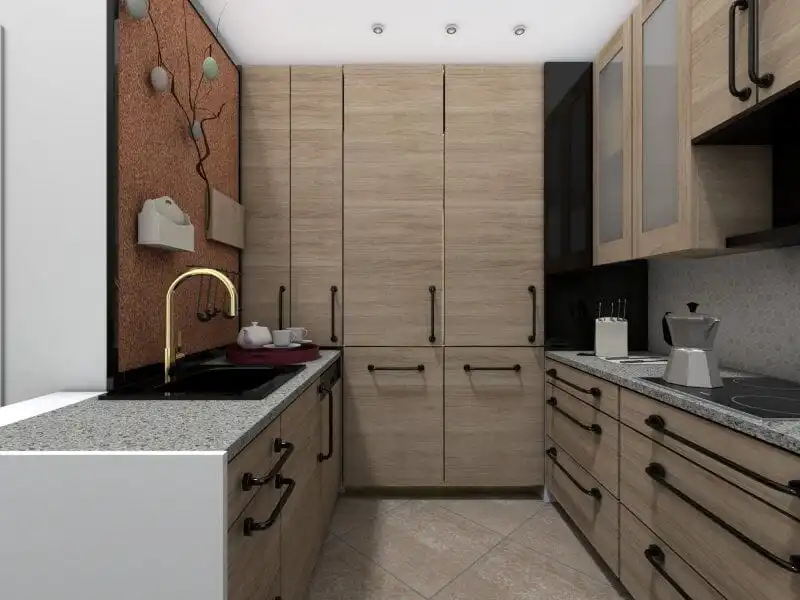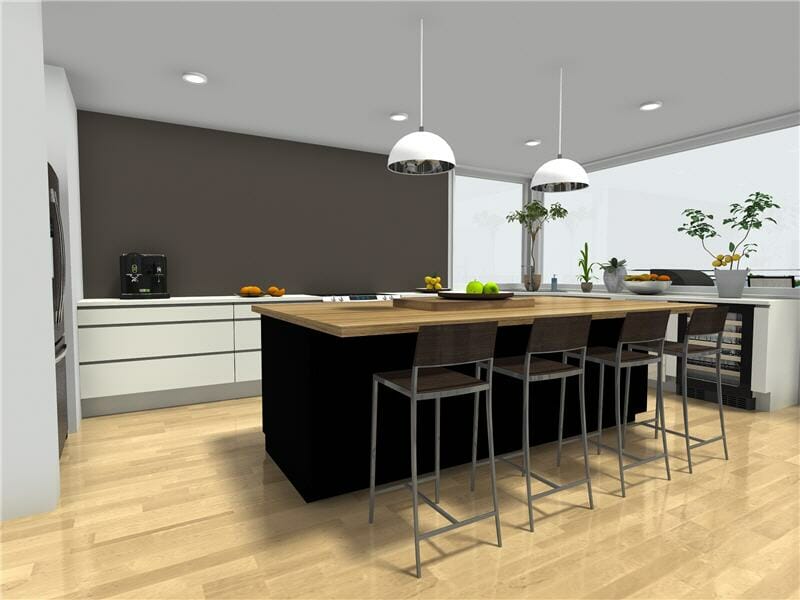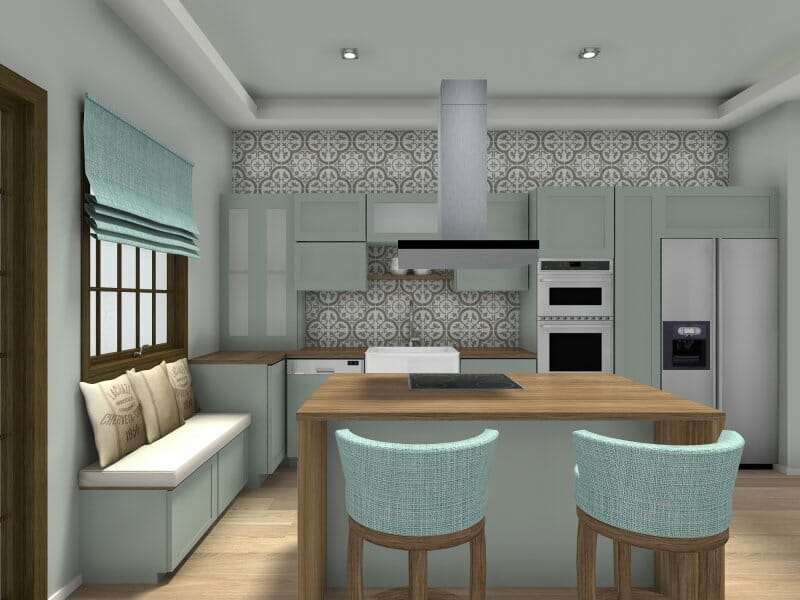How to Design a Kitchen Layout
Do you feel like designing a kitchen layout is overwhelming? It doesn't have to be. We’ve gathered a list of 9 simple steps to design a kitchen.

Whether you’re remodeling your kitchen or starting from scratch, designing the right layout is key. That’s why we collaborated with the experts at Modernize to create a list on how to design a kitchen layout:
1. Measure and Prioritize Your Kitchen Must-Haves
What kind of space and size do you have to work with? Get the correct measurements and consider what is most important to you in a kitchen. Is it the storage, the counter space, or maybe a farmhouse sink?
Remember, kitchens are personal; it’s important to design your kitchen for you and its use.
✏️ Draw Your Kitchen
If remodeling, draw your kitchen with doors and windows before sketching the new layout. This will make it easier to lay out your new design in the space you’re working with.
2. Place the Sink First

When creating a kitchen layout, many designers place the sink first and then design from there. While this is probably grounded in tradition from when people spent a long time scrubbing dishes, it remains a good rule of thumb.
Consider placing the sink with a view out a window or into the room. A kitchen island could be an excellent location for the sink if you want more counter space along the walls, for example, to place appliances such as a microwave or a stand mixer.
3. Make the Distance between the Main Fixtures Comfortable
Following the kitchen triangle, also called the kitchen work triangle, which is based on the placement of the stove, the sink, and the refrigerator for the most effective workflow.
Not only does a kitchen triangle provide an effective workflow, but it also helps the traffic in the kitchen when multiple people are working simultaneously, preventing people from bumping into each other when moving around.

It’s important to remember the main tasks – preparing, serving, and cleaning up meals.
To simplify these tasks, you don’t want the stove on the opposite side of the room from the sink or the fridge too far from the stove. Doing so only makes cooking more difficult than it needs to be.
Your kitchen layout design should place fixtures and appliances within comfortable proximity to each other, usually between 42 and 48 inches.

Preparing:
Preparing meals is a big part of the kitchen’s workflow, so you want this area to be practical. This is where you gather and prepare your ingredients, so it should be close to the sink for rinsing fruits and vegetables and near the fridge and storage for easy access to everything you need.
Cooking:
Keeping the cooking utensils close to the stove or oven is smart to avoid unnecessary distances when cooking. A set of drawers might be ideal for storing utensils and cutlery for serving.
Cleaning:
If you have a dishwasher, the sink and the dishwasher should be close to each other to make it easier to move from rinsing dirty dishes to putting them in the dishwasher. Also, ensure that the dish storage area is close to the dishwasher/cleaning area for easy access when putting clean dishes away.
5. Make Sure the Kitchen Island Isn’t too Close or too Far

A kitchen island is where much of the meal preparation happens. If your kitchen layout includes one, make sure to carefully consider its location.
Ensure the island will not block the area in front of your major appliances, such as wall ovens, dishwashers, and refrigerators.
Allow enough space for appliance doors to fully open, plus enough room to comfortably pass by when the doors are open. At the same time, you don’t want to place appliances too far apart. Ideally, your kitchen island should be within easy reach of key fixtures to keep everything efficient.
6. Prioritize Proper Ventilation, Not Just Placement
While traditional design recommended placing the stove on an exterior wall for easier venting, modern kitchens offer more flexibility.
With advanced downdraft systems and powerful recirculating or ducted range hoods, stoves can now be placed on islands or interior walls without sacrificing ventilation quality. Focus on selecting the right ventilation system for your layout.
7. Keep Vertical Storage in Mind

Instead of focusing on creating enough cabinet and drawer storage, use that energy to configure convenient wall storage.
Everyone’s kitchen needs are different, and your chosen storage type reflects that. A baker’s kitchen storage needs differ from a cook’s.
Storage walls are a great way to incorporate pantry storage, small appliances, baking accessories, extra china, or even a broom closet – in one convenient location.
Open shelves, wall hooks, and overhead pot racks are not only practical, but they also add dimension to the overall aesthetic.
📏 Kitchen Counter Measurements:
The standard height for kitchen counters is 36 inches (3 feet). However, if you’re taller than average, you might prefer a counter height of 38 inches instead.
The standard distance between kitchen counters and upper cabinets is 18 inches and should be no shorter than 15 inches.
8. Most Popular Kitchen Layouts

There are many different types of kitchens to choose from, and multiple shapes and sizes to keep in mind when designing a new one. Here is a list of the most popular kitchen layouts:
- L-shaped. Possibly the most popular kitchen layout, L-shaped kitchens are great for both small and big kitchens. You can add a kitchen island in bigger kitchens for even more counter space.
- One-wall. A one-wall or single-wall kitchen layout with an open floor plan is ideal for smaller kitchens in apartments, and it is a good way to save wall space. Combined with floor-to-ceiling cabinets, this can provide good storage solutions. If you want more counter space, upper cabinets or open shelves might be the way to go.
- U-shaped. This style can be done with an open floor plan or a separate room for those wanting more counter space.
- Peninsula. A type of L-shaped kitchen connected with an extended “arm”, resembling a U-shaped kitchen and simultaneously providing the benefits of a kitchen island.
- Galley style. This kitchen layout consists of two parallel counters with a walkway between them and is great for small spaces.
9. Create a Floor Plan and Visualize Your Kitchen in 3D

No matter how much designing, measuring, and pinning to your dream kitchen Pinterest boards you do, your completed kitchen can still come as a surprise once the contractors are finished – and not always in a good way.
By using a kitchen layout tool, you can easily avoid costly mistakes and irreversible flaws.
RoomSketcher provides an easy-to-use online kitchen planner. You can draw your kitchen floor plan, add fixtures, finishes, and cabinets, and see them instantly in 3D!
Don't forget to share this post!
Recommended Reads

4 Expert Kitchen Design Tips
Out of all of the rooms in your home, the layout of your kitchen matters most. Think like a kitchen designer with these 4 expert kitchen design tips.

Plan Your Kitchen With RoomSketcher
Need help planning a kitchen design? RoomSketcher shows you how to plan your kitchen with an online kitchen planner.

Large Kitchen Layout Design: 8 Common Mistakes to Avoid
Designing a large kitchen involves more than choosing the right appliances and color schemes. A well-thought-out layout is crucial, especially for larger kitchens.